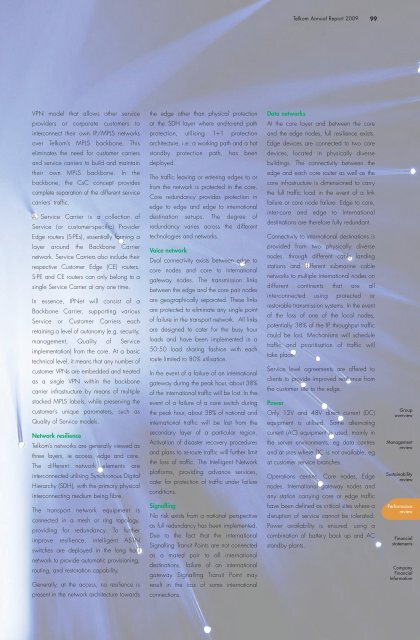Telkom AR front.qxp
Telkom AR front.qxp
Telkom AR front.qxp
Create successful ePaper yourself
Turn your PDF publications into a flip-book with our unique Google optimized e-Paper software.
VPN model that allows other service<br />
providers or corporate customers to<br />
interconnect their own IP/MPLS networks<br />
over <strong>Telkom</strong>’s MPLS backbone. This<br />
eliminates the need for customer carriers<br />
and service carriers to build and maintain<br />
their own MPLS backbone. In the<br />
backbone, the CsC concept provides<br />
complete separation of the different service<br />
carriers’ traffic.<br />
A Service Carrier is a collection of<br />
Service (or customer-specific) Provider<br />
Edge routers (S-PEs), essentially forming a<br />
layer around the Backbone Carrier<br />
network. Service Carriers also include their<br />
respective Customer Edge (CE) routers.<br />
S-PE and CE routers can only belong to a<br />
single Service Carrier at any one time.<br />
In essence, IPNet will consist of a<br />
Backbone Carrier, supporting various<br />
Service or Customer Carriers each<br />
retaining a level of autonomy (e.g. security,<br />
management, Quality of Service<br />
implementation) from the core. At a basic<br />
technical level, it means that any number of<br />
customer VPNs are embedded and treated<br />
as a single VPN within the backbone<br />
carrier infrastructure by means of multiple<br />
stacked MPLS labels, while preserving the<br />
customer’s unique parameters, such as<br />
Quality of Service models.<br />
Network resilience<br />
<strong>Telkom</strong>’s networks are generally viewed as<br />
three layers, ie access, edge and core.<br />
The different network elements are<br />
interconnected utilising Synchronous Digital<br />
Hierarchy (SDH), with the primary physical<br />
interconnecting medium being fibre.<br />
The transport network equipment is<br />
connected in a mesh or ring topology,<br />
providing for redundancy. To further<br />
improve resilience, intelligent ASTN<br />
switches are deployed in the long haul<br />
network to provide automatic provisioning,<br />
routing, and restoration capability.<br />
Generally, at the access, no resilience is<br />
present in the network architecture towards<br />
the edge other than physical protection<br />
at the SDH layer where end-to-end path<br />
protection, utilising 1+1 protection<br />
architecture, i.e. a working path and a hot<br />
standby<br />
deployed.<br />
protection path, has been<br />
The traffic leaving or entering edges to or<br />
from the network is protected in the core.<br />
Core redundancy provides protection in<br />
edge to edge and edge to international<br />
destination set-ups. The degree of<br />
redundancy varies across the different<br />
technologies and networks.<br />
Voice network<br />
Dual connectivity exists between edge to<br />
core nodes and core to international<br />
gateway nodes. The transmission links<br />
between the edge and the core pair nodes<br />
are geographically separated. These links<br />
are protected to eliminate any single point<br />
of failure in the transport network. All links<br />
are designed to cater for the busy hour<br />
loads and have been implemented in a<br />
50:50 load sharing fashion with each<br />
route limited to 80% utilisation.<br />
In the event of a failure of an international<br />
gateway during the peak hour, about 38%<br />
of the international traffic will be lost. In the<br />
event of a failure of a core switch during<br />
the peak hour, about 38% of national and<br />
international traffic will be lost from the<br />
secondary layer of a particular region.<br />
Activation of disaster recovery procedures<br />
and plans to re-route traffic will further limit<br />
the loss of traffic. The Intelligent Network<br />
platforms, providing advance services,<br />
cater for protection of traffic under failure<br />
conditions.<br />
Signalling<br />
No risk exists from a national perspective<br />
as full redundancy has been implemented.<br />
Due to the fact that the international<br />
Signalling Transit Points are not connected<br />
as a mated pair to all international<br />
destinations, failure of an international<br />
gateway Signalling Transit Point may<br />
result in the loss of some international<br />
connections.<br />
<strong>Telkom</strong> Annual Report 2009 99<br />
Data networks<br />
At the core layer and between the core<br />
and the edge nodes, full resilience exists.<br />
Edge devices are connected to two core<br />
devices, located in physically diverse<br />
buildings. The connectivity between the<br />
edge and each core router as well as the<br />
core infrastructure is dimensioned to carry<br />
the full traffic load in the event of a link<br />
failure or core node failure. Edge to core,<br />
inter-core and edge to International<br />
destinations are therefore fully redundant.<br />
Connectivity to international destinations is<br />
provided from two physically diverse<br />
nodes, through different cable landing<br />
stations and different submarine cable<br />
networks to multiple international nodes on<br />
different continents that are all<br />
interconnected using protected or<br />
restorable transmission systems. In the event<br />
of the loss of one of the local nodes,<br />
potentially 38% of the IP throughput traffic<br />
could be lost. Mechanisms will schedule<br />
traffic and prioritisation of traffic will<br />
take place.<br />
Service level agreements are offered to<br />
clients to provide improved resilience from<br />
the customer site to the edge.<br />
Power<br />
Only 12V and 48V direct current (DC)<br />
equipment is utilised. Some alternating<br />
current (AC) equipment is used, mainly in<br />
the server environments, eg data centres<br />
and at sites where DC is not available, eg<br />
at customer service branches.<br />
Operations centres, Core nodes, Edge<br />
nodes, International gateway nodes and<br />
any station carrying core or edge traffic<br />
have been defined as critical sites where a<br />
disruption of service cannot be tolerated.<br />
Power availability is ensured, using a<br />
combination of battery back up and AC<br />
standby plants.<br />
Group<br />
overview<br />
Management<br />
review<br />
Sustainability<br />
review<br />
Performance<br />
review<br />
Financial<br />
statements<br />
Company<br />
Financial<br />
Information




